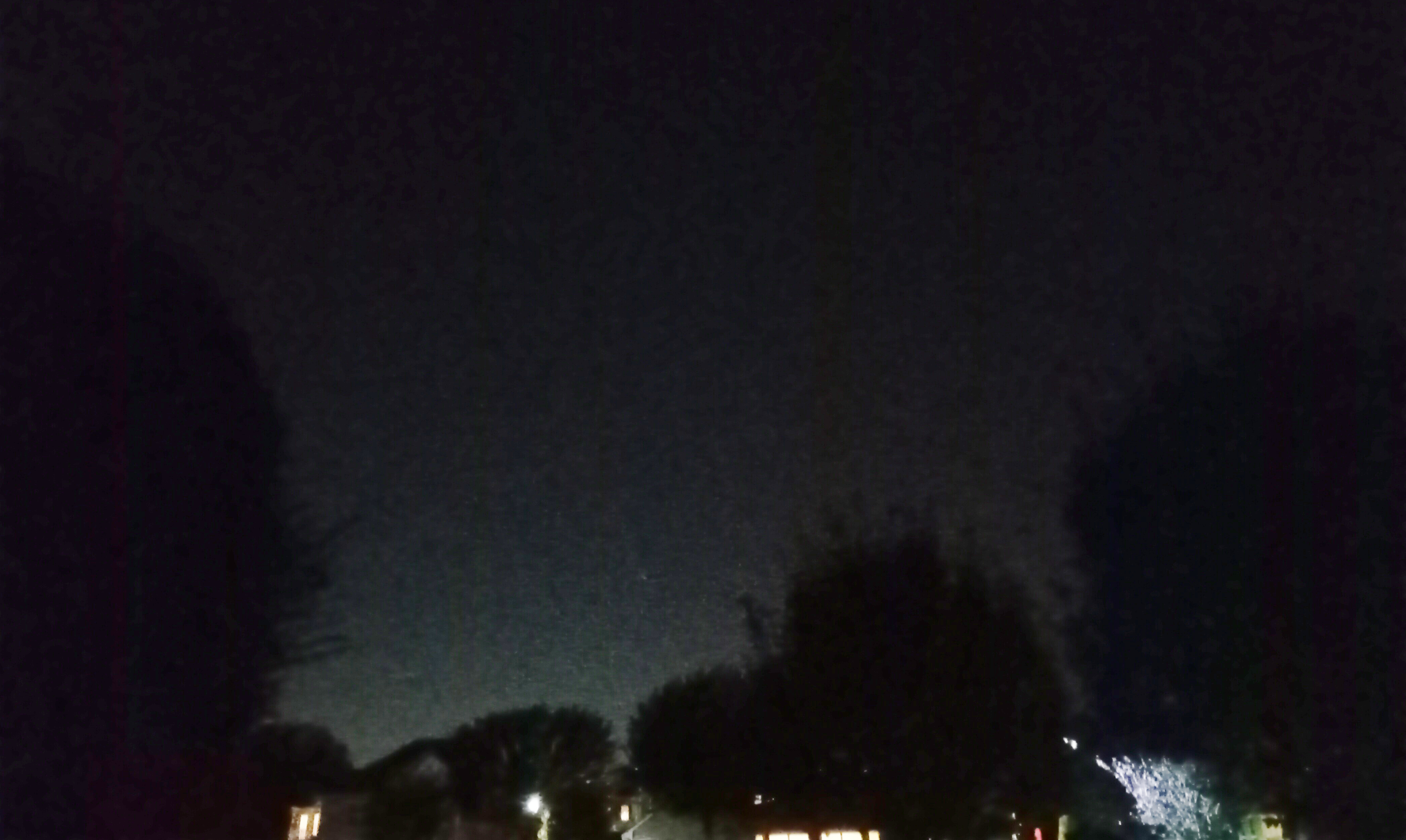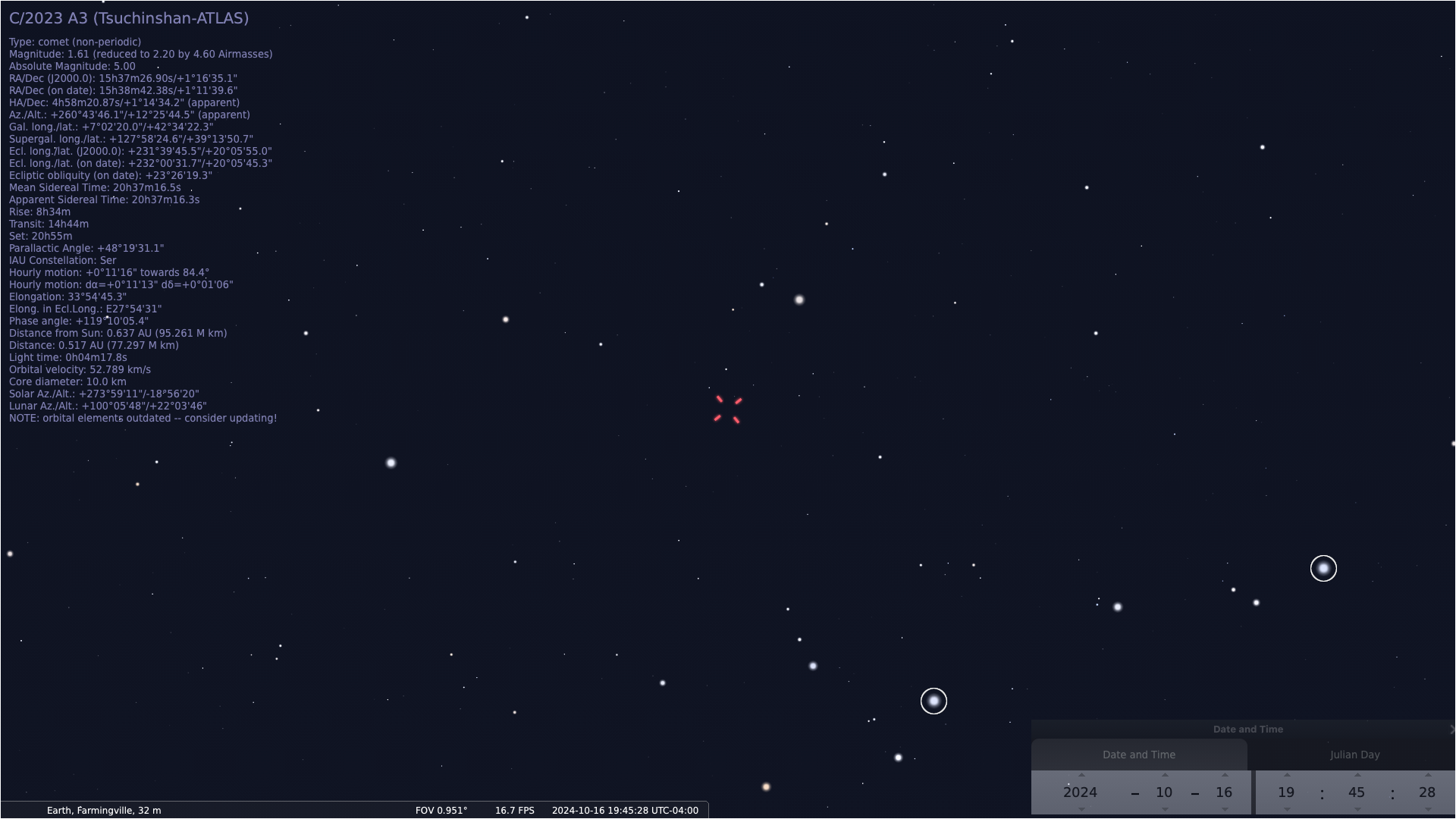
Comet A3-2023 Tsuchinshan Atlas as imaged at 19:45 (7:45) EDT by the author on October 16, 2024 with 11×80 binoculars and a mobile phone held up to the binocular eyepiece. To give a sense of actual brightness (of the comet), there are 6.5 and 6.7 magnitude stars due west and north of west of the comet (diagonally oriented towards the bottom and side of the frame respectively). The limiting visual threshold for the human eye is magnitude 6.0 under the best conditions. 1/2 second exposure. See stellarium view at the foot of this article for the field stars and their locations relative to the comet.
Why should it cost you thousands of dollars to enjoy astronomy? It doesn’t and it shouldn’t. All you have to do is “look up” on a clear, dark moonless night to enjoy the beauty of the night sky.
But what if I want to get a closer look at the moon or Saturn’s rings, for example?
To physically observe these objects with your eye, through a telescope, is the best way to nurture a budding interest in astronomy. How do I know that? Because that’s exactly the way my life-long interest in and love for authentic astronomy began. Such a telescope would be a basic 15 cm (6”) Newtonian reflecting telescope in the $200 — $400 range; no expensive cameras or “imaging equipment” necessary. Physically observing celestial objects through a telescope makes a visceral connection with the object of interest and the observer, producing a lasting memory that encourages the nascent astronomer to explore further.
A Basic Example
The image above was produced by the author using a pair of 11×80 binoculars and his mobile phone — that’s all. A proper visual representation of the comet is realized in this image along with the natural, observed color (a light “golden white” hue is observed). Many images on the internet exaggerate the comet’s appearance, creating unrealizable expectations followed by disappointment for a casual observer or someone who would otherwise have a genuine interest in astronomy. The image here is an example. In fact, this image is for sale or “licensable” (and is not reproduced here), and illustrates the point. It was produced on October 16, the same day as the image above and the day after the following image, both produced by the author, and does not realistically represent the comet’s appearance in the sky. The following image does:

With twilight soon ending, this is a realistic view of the “naked eye” Comet A3-2023 Tsuchinshan Atlas from downstate, New York, October 15, 7:25 PM, EDT. The comet is centrally located and visible above the tree line. Unlike the hyper-enhanced images often seen in periodicals or published online, this is how the comet actually appeared to the unaided eye. 1/2 second exposure.
Astronomy as the Oldest of the Sciences
Astronomy is the oldest of the sciences and understandably so. Our ancient forebears would look up at the canopy above following the setting sun. Their imaginations ran wild and conjured up all kinds of scenarios, some quite far-fetched, some remarkably realistic.
Unfortunately, today, with the very same technology that allows us to capture the heavens above so quickly and in remarkable detail has also stolen the minds of the young. As an educator, I see this every day with some young people borderline uneducable. As adults, it’s often difficult for us to disconnect from the technology that we’ve imposed on ourselves, since many of our daily activities now require us to own a “mobile device”.
Astrophotography is not Astronomy
Many have invested a small fortune in the latest imaging device or optical platform to “capture” the night sky. To be clear, this activity, widely known as “astrophotography”, is not astronomy, although a certain basic knowledge of a given target may be necessary to properly “image” that object. Astronomy is a science, the oldest of the sciences. In the vernacular, “Imaging” these objects or “taking pictures” of them, while a fulfilling hobby in its own right, is not astronomy.
Professional astronomers image objects of interest for an entirely different reason. Capturing photons, the quantized packets of light that produced the “image” of the object, is necessary to study what physical processes gave rise to that photon. That study may allow us to quantify how long the photon took to reach us and thus how far away the object of interest is, for example.
The large sums of money often spent on astrophotography equipment is generally spent on the imaging device (the camera) or on small-aperture, high-end optical components. And this is where my biggest objection lies. There is no getting around the “bigger is always better” paradigm in observational astronomy. What you can see, either photographically or visually, is completely determined by the telescope’s aperture.
Vast sums of money spent on expensive, high-end camera equipment can never compensate for a small aperture.
What is my point? To the novice or those who have a budding interest in astronomy, this could be daunting. They need not spend more than $500 to be fully equipped to enjoy basic telescopic astronomy. I recommend a 15 cm (6″) or 20 cm (8″) Newtonian reflecting telescope.
Aperture, aperture, aperture
Aperture determines everything in observational astronomy. The two essential aspects of any image or visual observation are determined by the telescope’s aperture:
- light gathering ability (the ability to collect light — the greater the surface area, the more light is collected, thus determining how faint an object can be observed or conversely, how bright an object will appear) and
- resolution, the ability to discern fine detail.
These two aspects of a telescope trump everything else and are determined by the physical aperture (diameter) of the telescope. There is no way around this and no other technological solution.
Whether an image is produced using legacy film or modern digital cameras, a simple rule still applies: the longer the exposure, the more photons are captured. Many of the stunning images of the comet seen on the internet were produced with extended (multi-second) time exposures. The longer the exposure, the more light is captured and thus, a brighter, more enhanced image is produced. You may ask here: why can’t this suffice in place of aperture?
- The Light gathering power of any telescope/camera combination is completely determined by the telescope’s aperture. It is a time-dependent property of any camera/telescope combination. The longer the exposure, the more photons are captured through the existing aperture — again, the limiting component here is the aperture, not the camera.
- Reciprocity failure was an aspect of legacy film media where the efficacy of the film decreased with time — the longer the exposure, the less sensitive the film became. This is not true for digital cameras, however. There is one more dimension to consider:
- The earth’s rotation. For exposures with standard lens and camera configurations (mobile-phone cameras would be included here), any image whose exposure was greater than 10 seconds would suffer from “star trails”. We’re standing on a giant, rotating sphere, the earth! Celestial objects are essentially at infinity. All stars are considered point sources, and thus any camera on a moving or rotating platform (the earth) would produce a “star trail” as the image of a star. This is solved with a “clock drive”, however, a motorized platform or mounting for the telescope/camera combination that moves at the same angular speed our object of interest (comet, star, planet, etc.) appears to move due to the earth’s rotation. Our exposures above were a default value of about 1/2 second.
Why am I disparaging Astrophotography?
I am not really disparaging astrophotography. Many astronomers, amateur and professional, engage in astrophotography for a variety of reasons. Some as a hobby (which is fine) with the understanding that the image they may have just produced is about the millionth iteration or version of the same object, others, perhaps for professional reasons. My intention here is not to cast aspersions, but to provide realistic expectations for the novice or someone who may be interested in astronomy and to provide a modicum of guidance on what they should expect to see.
Field of Comet A3 Tsuchinshan Atlas at 19:45 (7:45) EDT, October 16, 2024

The field in the constellation Serpens containing Comet A3-2023 Tsuchinshan Atlas (identified by the red “X”) on the night of October 16, 2024 at 19:45 EDT. The two field stars identified in the binocular image at the top of the page (magnitude 6.7 and 6.5 from left to right) are circled in the right-hand quadrant of the frame. Modified image via Stellarium.



